
Rock Island County Soil and Water Conservation District
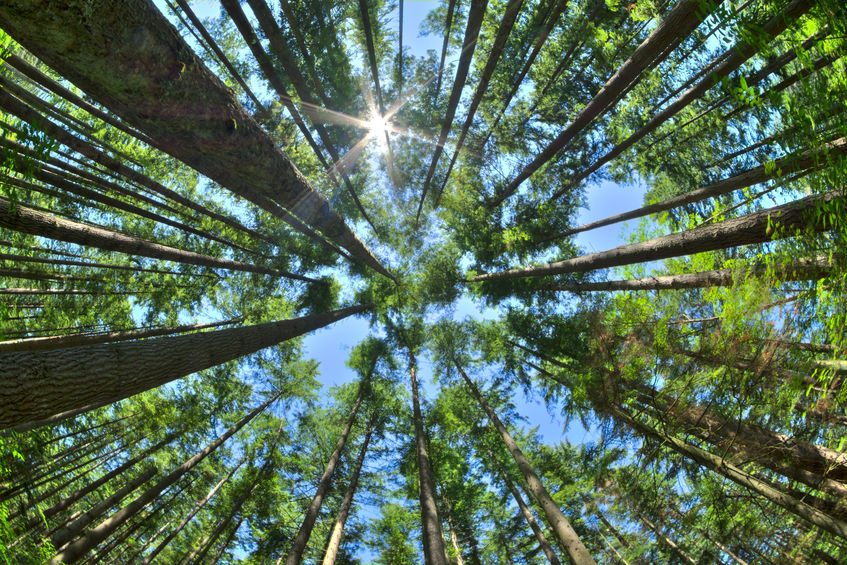


All trees and shrubs are 3 gallon conservation grade or commercial grade containers (commercial grade will be specified) ranging from 2-8 ft tall unless otherwise noted. All orders must be in advance.
Directions to QCCA Expo Center
Hackberry (Celtis occidentalis) - $26 EACH
Hackberry is a Chicago-area native and a sturdy, tolerant shade tree for parkways, parks, and other large areas. Its fleshy, purple-brown berries ripen in late summer and persist through winter. The persistent fruits attract many birds that also find the tree to be a suitable nesting site.
This species is native to the Chicago region according to Swink and Wilhelm's Plants of the Chicago Region, with updates made according to current research.
Alleghany Serviceberry (Amelanchier Laevis)- $27 EACH
Allegheny serviceberry is a small, native, understory tree with four-season interest. The early white spring flowers, outstanding orange-red fall color, and striking gray bark make it a lovely specimen for any landscape. The edible purplish-black fruit in late summer is attractive to many birds.
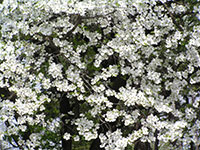
White Flowering Dogwood (Cornus florida) - $27 EACH
Flowering dogwood is a small to medium woodland understory tree, native throughout most of the eastern United States. Showy white, red, or pink flowering bracts appear before the leaves in early spring. Dark green summer foliage turns a brilliant reddish-purple in fall. It is sensitive to adverse soil and environmental conditions such as road salt and pollution. Best planted in acidic soil.
This species is native to the Chicago region according to Swink and Wilhelm’s Plants of the Chicago Region, with updates made according to current research.
Size Range:
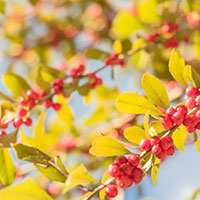
Deciduous Holly (ilex decidua)- $24 EACH
A large shrub or small tree producing white flowers in late spring followed by red berries on female plants in fall/winter. Fruiting requires pollination from a male plant. The berries persist through winter and are an important food source for birds.
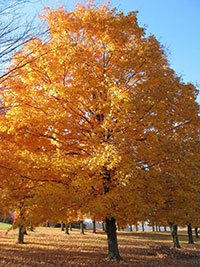
Sugar Maple (Acer Saccharum)- $27 EACH
Sugar maple is a Midwest native loved for its exceptional fall color ranging from brilliant yellow to burnt-orange. In summer, its lustrous foliage provides excellent shade, making it a great choice for parks, golf courses, and home landscapes where its roots can spread.
Strawberry Bush (Euonymus americanus) - $27 EACH
Noted for its very ornamental fruits and attractive color, Euonymus americanus is an airy, deciduous shrub with slender stems bearing opposite, lance-shaped, bright green leaves, 2 inches long. The foliage turns subtle shades of orange and red in the fall. In the late spring to early summer, a profusion of tiny, pale green flowers with 5 clawed petals and purple stamens bloom. They are very attractive to birds and small mammals and are a great source of fat and sugar for the animals. Each seed capsule splits open to reveal pea-sized, bright orange and red berries.
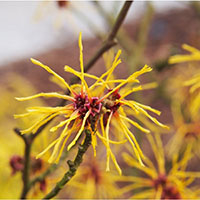
Common Witch-Hazel (Hamamelis virginiana) - $27 EACH
Common witch-hazel is a large shrub with a picturesque irregular branching habit that naturally grows along woodland edges. The large, rounded, dark green leaves often hang onto the winter branches. The yellow strap-like flowers of this native shrub are among the last blooms to appear in fall, but are often hidden by the leaves. The fruit capsules mature a year after flowering, splitting open to expel seeds that are attractive to birds. Tolerant of road salt and clay soil. This is a great specimen plant or in a naturalized landscape.
Shellbark Hickory (Carya Iaciniosa)- $30 EACH
Shellbark hickory is a large tree with shaggy bark and good yellow fall color. Shellbark hickory trees are culinarily prized for their aromatic wood and charcoal which gives food a distinct smokey flavor. This wood is very strong and dense, making it excellent for tools, basket handles, and flooring. It also has a high thermal content, which made it an ideal fuel source historically. Hickory trees, along with other select hardwood species, are also associated with the growth of morel mushrooms. Morels are an increasingly popular culinary delight, which may provide a financial incentive to keep shellbark hickory trees growing in the forest for a long time.
American Chestnut (Castanea Dentata)- $27 EACH
The American chestnut was once the king of the forest. It was a magnificent tree used for lumber and for food. Chestnut blight began to decimate this species in the early 1900's. The American chestnut is not extinct. It survives in the wild in the form of root systems and stump sprouts. There are also ongoing efforts to develop trees that are resistant to the disease.
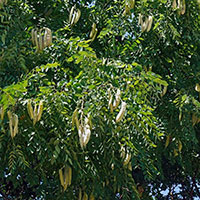
Kentucky Coffeetree (Gymnocladus dioicus)- $30 EACH
The Kentucky coffeetree's tolerance to pollution and a wide range of soils makes it a suitable tree for urban environments. Native to the Midwest, this tree bears leathery, reddish-brown seed pods that add winter interest to the Midwestern landscape.

Black Walnut (Juglans nigra) - $26 EACH
The black walnut is a Chicago-area native tree that provides excellent shade for large properties. It needs to be sited with care, since the tree produces a chemical that is toxic to some other plants. The fruit is a rounded, yellow-green husk containing a nut that is a food source for squirrels. The black walnut also attracts the banded hairstreak butterfly, serving as a caterpillar host.
Blackgum (Nyssa sylvatica) - $30
Black gum or black tupelo is a medium-sized, native deciduous tree in the Nyssaceae family. Growing throughout North Carolina in dry upland forests, occasionally in bottomlands, savannas, swamp margins, and upland depressions that are occasionally flooded. It can also be found in the hills and mountains on dry slopes with oaks and hickories. The black gum is grown as an ornamental for its beautiful, scarlet red, fall color and for its shiny, dark green leaves in the summer.
Overcup Oak (Quercus lyrata) - $28 EACH
Overcup oak is a deciduous tree in the Fagaceae (oak) family native to central and southeast North America and can be found in the coastal and coastal plains of NC, although not abundantly. In spite of its natural occurrence where periodical flooding is typical, overcup oak grows well on sites with better drainage and soil texture. It gets its common name from the distinctive bur-like acorn cup that typically encloses 2/3 to almost all of the nut. This renders it buoyant in flood areas. Fall color is variable from yellow or brown to red.
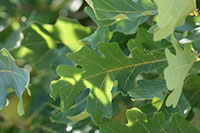
White Oak (Quercus alba)- $27 EACH
White oak is a massive, long-lived stately tree with wide spreading horizontal branches and wine-red fall color. This native tree provides shade for larger landscapes and parks.
Swamp White Oak (Quercus bicolor)- $27 EACH
Swamp white oak is a striking tree with attractive peeling bark, which is especially prevalent on young trees. The lustrous, lobed leaves have a two-tone appearance, dark green on top with a silvery-white underside. Fall color is an orange-gold to yellow in mid-autumn. An excellent shade tree for any landscape.
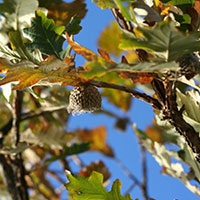
Bur Oak (Quercus macrocarpa) - $26 EACH
The stately bur oak, native to the Midwest, is a great choice as a shade tree and for specimen plantings in parks, spacious yards, and other large areas. Its massive trunk has gray to brown furrowed bark and its branches bear lustrous dark green leaves that turn yellow-brown in fall. Large acorns with fringed caps attract birds and small mammals. This species is native to the Chicago region according to Swink and Wilhelm's Plants of the Chicago Region, with updates made according to current research.
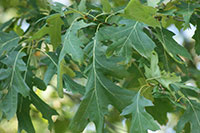
Black Oak (Quercus velutina) - $26 EACH
Black oak, a native of the Chicago region, could be used as a parkway or street tree. Fall color is yellow to yellow-brown. This species is not offered in commerce as often as other oak species. This species is native to the Chicago region according to Swink and Wilhelm's Plants of the Chicago Region, with updates made according to current research.
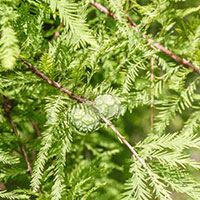
Bald-cypress (Taxodium distichum) - $26 EACH
This stately conifer, native to the Midwest, is often found in groupings in parks and larger spaces, along streets, and around lakes. Unlike most cone-bearing trees, bald-cypress loses its needles each winter and grows a new set in spring. The russet-red fall color of its lacy needles is one of its outstanding characteristics. Hardy and tough, this tree will adapt to a wide range of soil types, whether wet, dry, or swampy.
Blackberry – Illinois Hardy (thorny) - $15 EACH
Blackberry
Aborvitae – Green Giant - $30 EACH
Aboritae
Common Lilac - $15 EACH
Lilac
Blueberry Kit (Sunrise and Hannah) - $60 EACH
Two, 2–3-year-old plants, in one-gallon pots, peat moss, acidifier and fertilizer